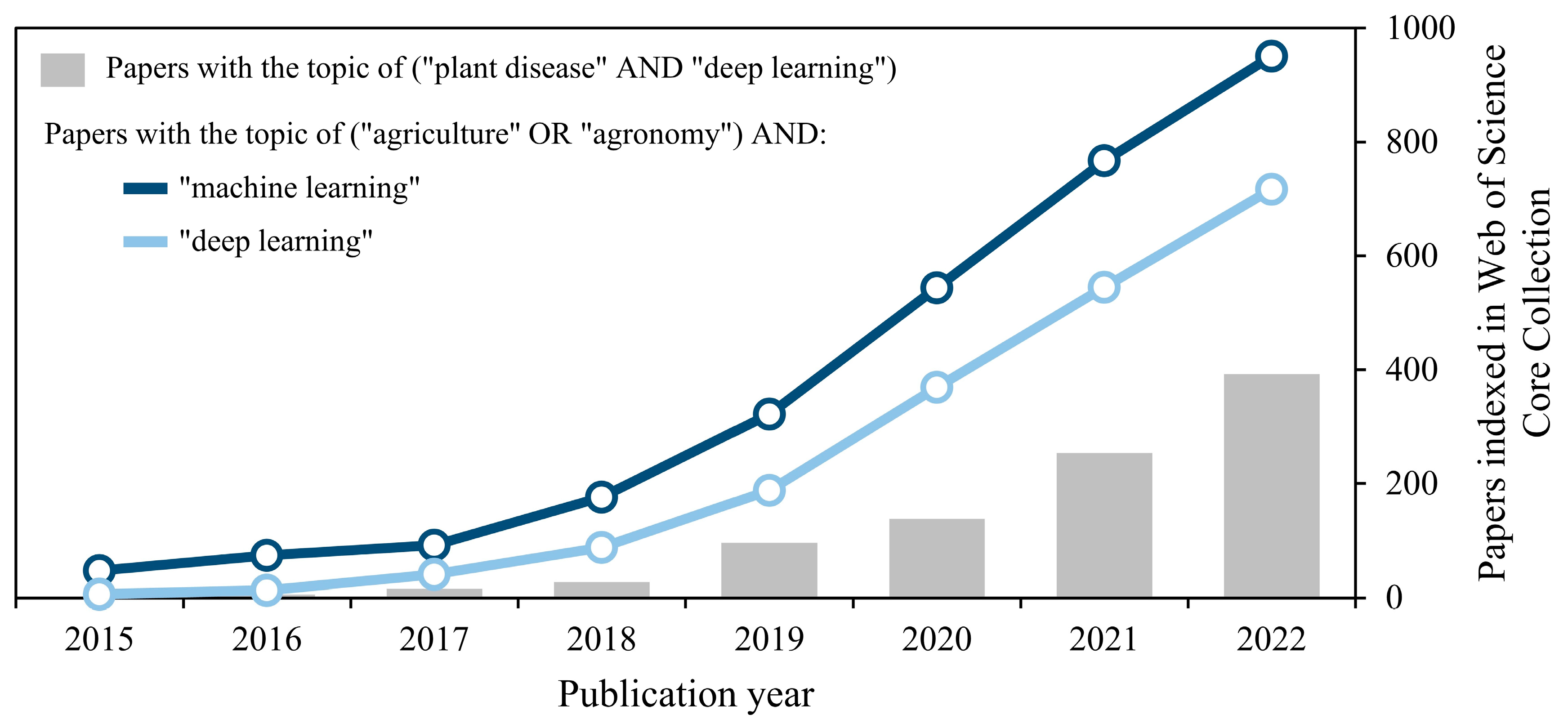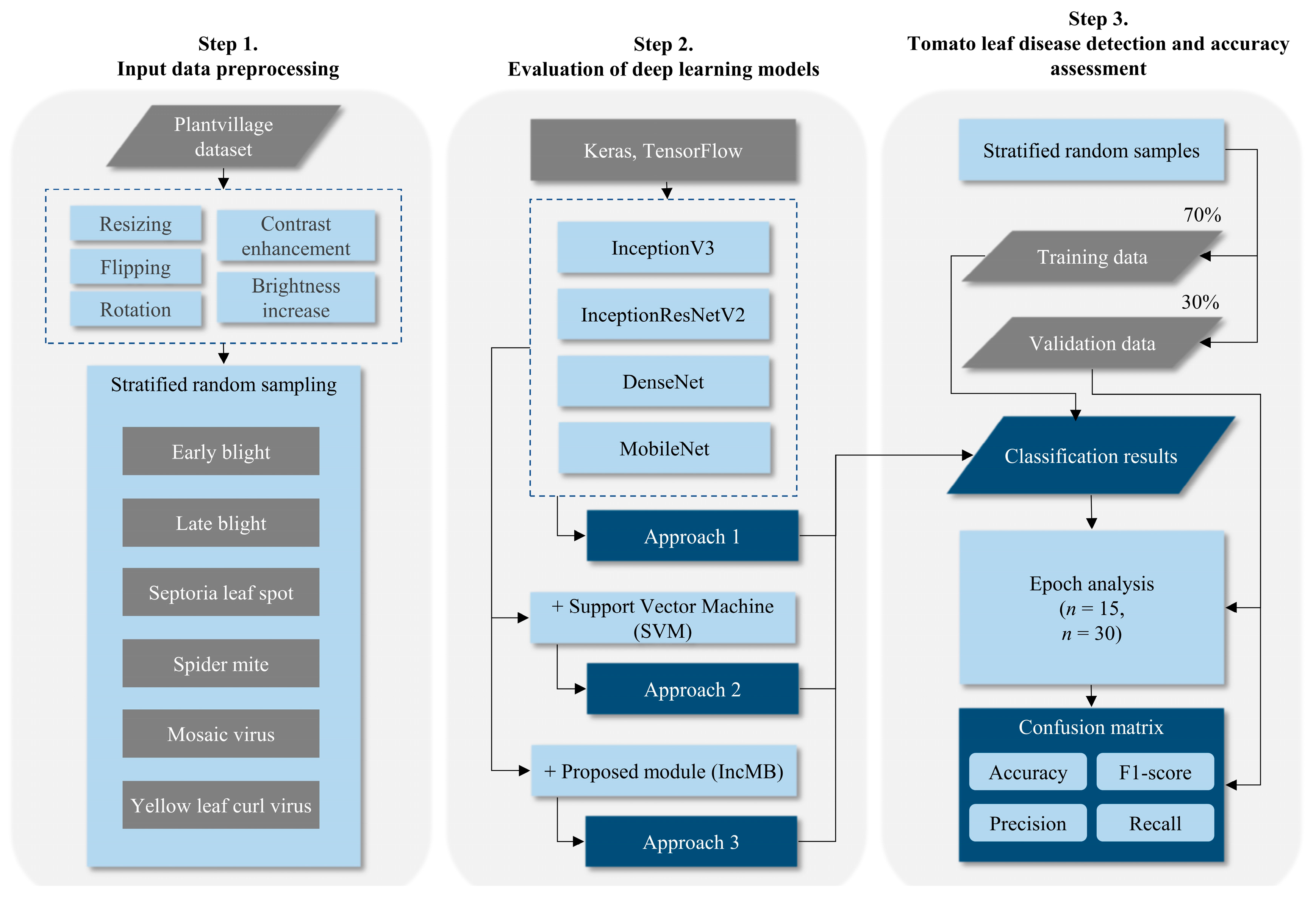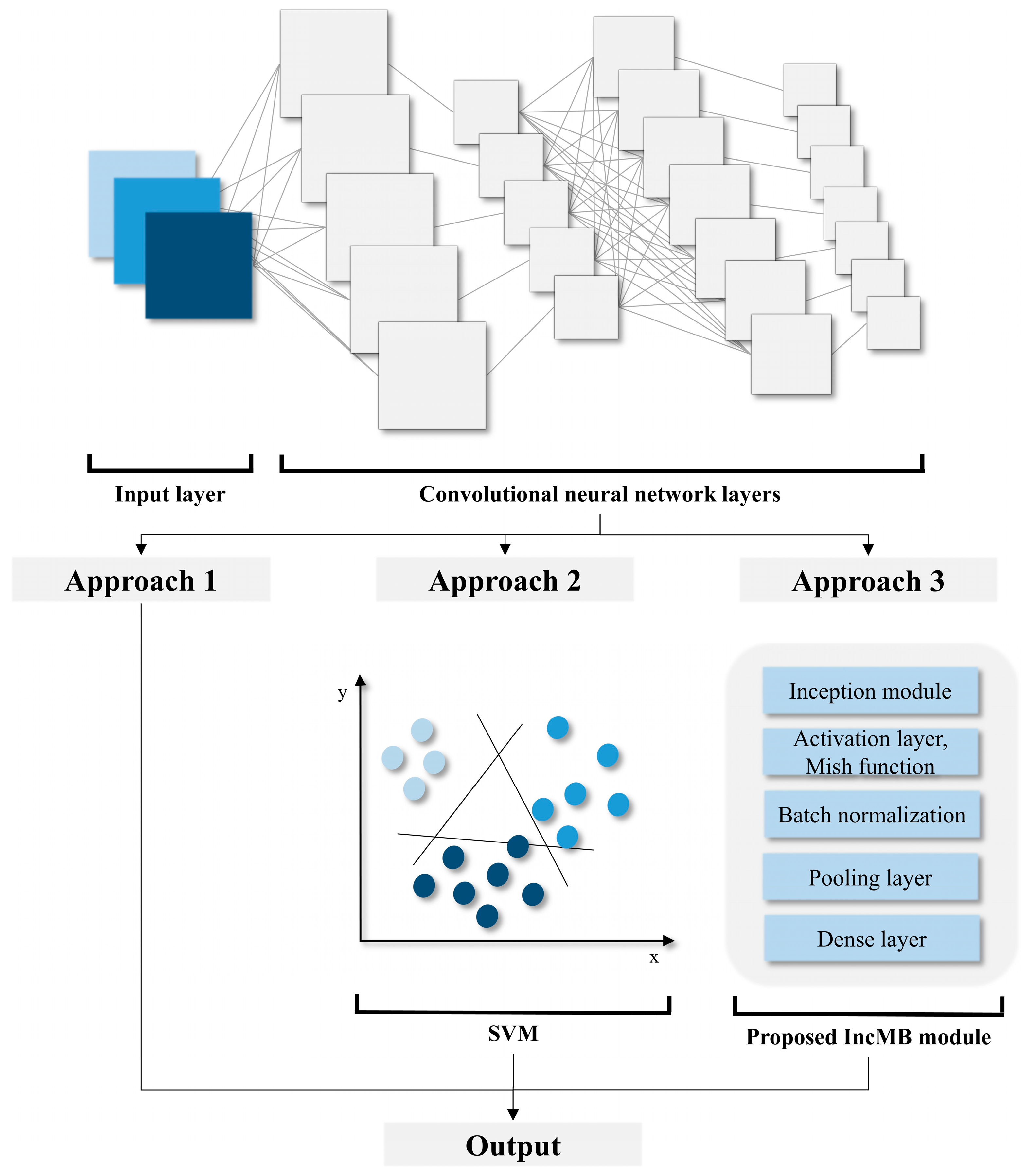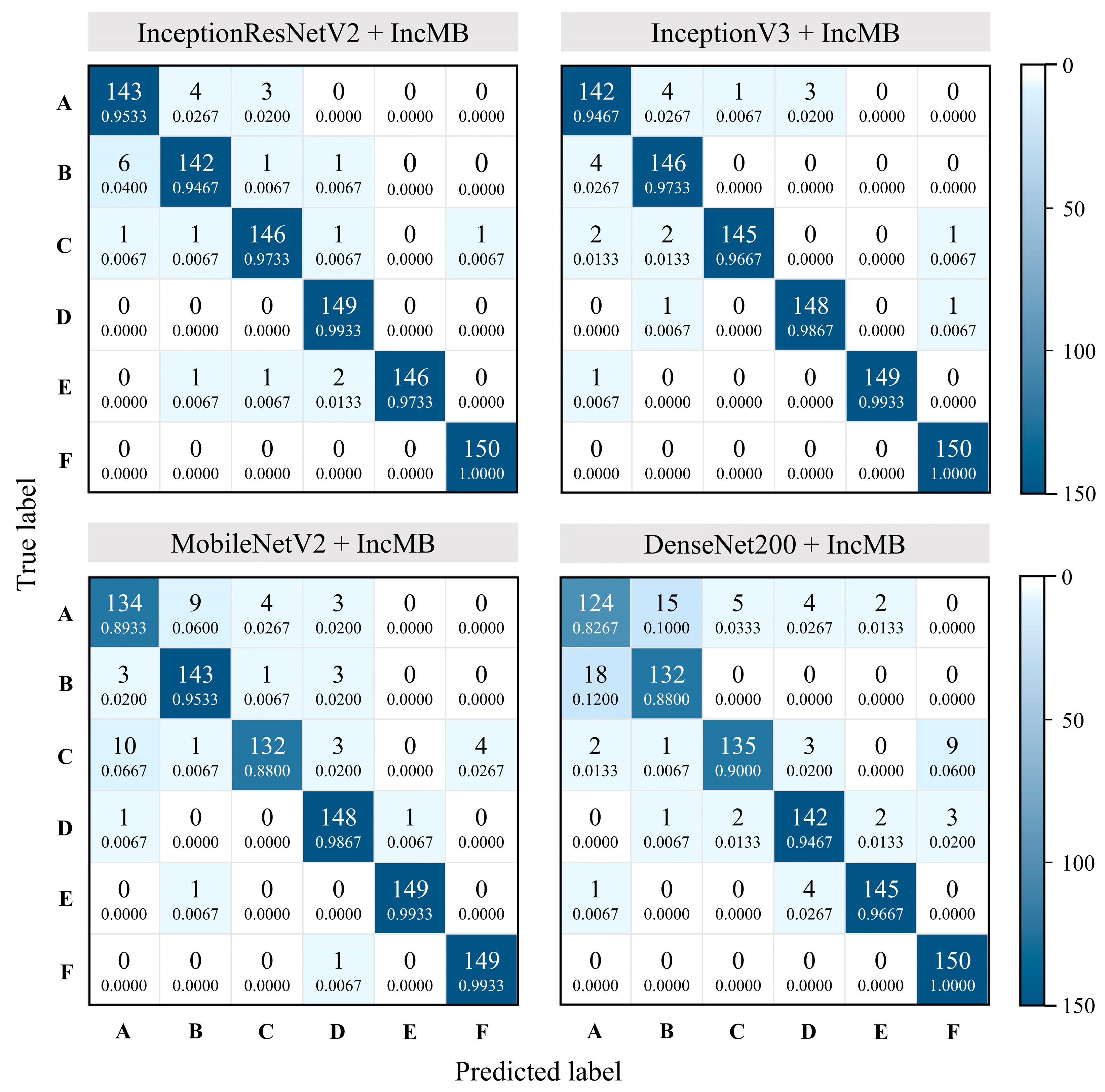Image-Based Leaf Disease Recognition Using Transfer Deep Learning with a Novel Versatile Optimization Module
Abstract
1. Introduction
2. Related Works
3. Materials and Methods
3.1. Data Preprocessing and Experimental Setup
3.2. Structure of Transfer Deep Learning Networks for Tomato Leaf Disease Recognition
3.3. Structure of the Novel IncMB Module
3.4. Tomato Leaf Disease Accuracy Assessment
4. Results
5. Discussion
6. Conclusions
Author Contributions
Funding
Institutional Review Board Statement
Informed Consent Statement
Data Availability Statement
Conflicts of Interest
References
- Fróna, D.; Szenderák, J.; Harangi-Rákos, M. The Challenge of Feeding the World. Sustainability 2019, 11, 5816. [Google Scholar] [CrossRef]
- Van Dijk, M.; Morley, T.; Rau, M.L.; Saghai, Y. A Meta-Analysis of Projected Global Food Demand and Population at Risk of Hunger for the Period 2010–2050. Nat. Food 2021, 2, 494–501. [Google Scholar] [CrossRef]
- Ahmad, A.; Saraswat, D.; El Gamal, A. A Survey on Using Deep Learning Techniques for Plant Disease Diagnosis and Recommendations for Development of Appropriate Tools. Smart Agric. Technol. 2023, 3, 100083. [Google Scholar] [CrossRef]
- Das, S.; Pattanayak, S.; Behera, P.R. Application of Machine Learning: A Recent Advancement in Plant Diseases Detection. J. Plant Prot. Res. 2022, 62, 122–135. [Google Scholar] [CrossRef]
- Hasan, R.I.; Yusuf, S.M.; Alzubaidi, L. Review of the State of the Art of Deep Learning for Plant Diseases: A Broad Analysis and Discussion. Plants 2020, 9, 1302. [Google Scholar] [CrossRef] [PubMed]
- Liu, J.; Wang, X. Plant Diseases and Pests Detection Based on Deep Learning: A Review. Plant Methods 2021, 17, 22. [Google Scholar] [CrossRef] [PubMed]
- Sharma, V.; Tripathi, A.K.; Mittal, H. Technological Revolutions in Smart Farming: Current Trends, Challenges & Future Directions. Comput. Electron. Agric. 2022, 201, 107217. [Google Scholar] [CrossRef]
- FAOSTAT. 2021. Available online: https://www.fao.org/faostat/en/ (accessed on 11 December 2022).
- Litskas, V.D.; Migeon, A.; Navajas, M.; Tixier, M.-S.; Stavrinides, M.C. Impacts of Climate Change on Tomato, a Notorious Pest and Its Natural Enemy: Small Scale Agriculture at Higher Risk. Environ. Res. Lett. 2019, 14, 084041. [Google Scholar] [CrossRef]
- Ghisbain, G.; Gérard, M.; Wood, T.J.; Hines, H.M.; Michez, D. Expanding Insect Pollinators in the Anthropocene. Biol. Rev. 2021, 96, 2755–2770. [Google Scholar] [CrossRef]
- Ferracini, C.; Bueno, V.H.P.; Dindo, M.L.; Ingegno, B.L.; Luna, M.G.; Salas Gervassio, N.G.; Sánchez, N.E.; Siscaro, G.; van Lenteren, J.C.; Zappalà, L.; et al. Natural Enemies of Tuta Absoluta in the Mediterranean Basin, Europe and South America. Biocontrol Sci. Technol. 2019, 29, 578–609. [Google Scholar] [CrossRef]
- Guedes, R.N.C.; Roditakis, E.; Campos, M.R.; Haddi, K.; Bielza, P.; Siqueira, H.A.A.; Tsagkarakou, A.; Vontas, J.; Nauen, R. Insecticide Resistance in the Tomato Pinworm Tuta Absoluta: Patterns, Spread, Mechanisms, Management and Outlook. J. Pest Sci. 2019, 92, 1329–1342. [Google Scholar] [CrossRef]
- Ramos, R.S.; Kumar, L.; Shabani, F.; Picanço, M.C. Risk of Spread of Tomato Yellow Leaf Curl Virus (TYLCV) in Tomato Crops under Various Climate Change Scenarios. Agric. Syst. 2019, 173, 524–535. [Google Scholar] [CrossRef]
- He, D.-C.; He, M.-H.; Amalin, D.M.; Liu, W.; Alvindia, D.G.; Zhan, J. Biological Control of Plant Diseases: An Evolutionary and Eco-Economic Consideration. Pathogens 2021, 10, 1311. [Google Scholar] [CrossRef]
- Xu, L.; Abd El-Aty, A.M.; Eun, J.-B.; Shim, J.-H.; Zhao, J.; Lei, X.; Gao, S.; She, Y.; Jin, F.; Wang, J.; et al. Recent Advances in Rapid Detection Techniques for Pesticide Residue: A Review. J. Agric. Food Chem. 2022, 70, 13093–13117. [Google Scholar] [CrossRef] [PubMed]
- Cordon, G.; Andrade, C.; Barbara, L.; María Romero, A. Early Detection of Tomato Bacterial Canker by Reflectance Indices. Inf. Process. Agric. 2022, 9, 184–194. [Google Scholar] [CrossRef]
- Panno, S.; Davino, S.; Caruso, A.G.; Bertacca, S.; Crnogorac, A.; Mandić, A.; Noris, E.; Matić, S. A Review of the Most Common and Economically Important Diseases That Undermine the Cultivation of Tomato Crop in the Mediterranean Basin. Agronomy 2021, 11, 2188. [Google Scholar] [CrossRef]
- Sujatha, R.; Chatterjee, J.M.; Jhanjhi, N.; Brohi, S.N. Performance of Deep Learning vs Machine Learning in Plant Leaf Disease Detection. Microprocess. Microsyst. 2021, 80, 103615. [Google Scholar] [CrossRef]
- Bhatt, D.; Patel, C.; Talsania, H.; Patel, J.; Vaghela, R.; Pandya, S.; Modi, K.; Ghayvat, H. CNN Variants for Computer Vision: History, Architecture, Application, Challenges and Future Scope. Electronics 2021, 10, 2470. [Google Scholar] [CrossRef]
- Albattah, W.; Nawaz, M.; Javed, A.; Masood, M.; Albahli, S. A Novel Deep Learning Method for Detection and Classification of Plant Diseases. Complex Intell. Syst. 2022, 8, 507–524. [Google Scholar] [CrossRef]
- Hughes, D.P.; Salathe, M. An Open Access Repository of Images on Plant Health to Enable the Development of Mobile Disease Diagnostics. arXiv 2015, arXiv:1511.08060. [Google Scholar]
- Lee, S.H.; Goëau, H.; Bonnet, P.; Joly, A. New Perspectives on Plant Disease Characterization Based on Deep Learning. Comput. Electron. Agric. 2020, 170, 105220. [Google Scholar] [CrossRef]
- Ramcharan, A.; Baranowski, K.; McCloskey, P.; Ahmed, B.; Legg, J.; Hughes, D.P. Deep Learning for Image-Based Cassava Disease Detection. Front. Plant Sci. 2017, 8, 1852. [Google Scholar] [CrossRef]
- Chen, J.; Chen, J.; Zhang, D.; Sun, Y.; Nanehkaran, Y.A. Using Deep Transfer Learning for Image-Based Plant Disease Identification. Comput. Electron. Agric. 2020, 173, 105393. [Google Scholar] [CrossRef]
- Saeed, A.; Abdel-Aziz, A.A.; Mossad, A.; Abdelhamid, M.A.; Alkhaled, A.Y.; Mayhoub, M. Smart Detection of Tomato Leaf Diseases Using Transfer Learning-Based Convolutional Neural Networks. Agriculture 2023, 13, 139. [Google Scholar] [CrossRef]
- Attallah, O. Tomato Leaf Disease Classification via Compact Convolutional Neural Networks with Transfer Learning and Feature Selection. Horticulturae 2023, 9, 149. [Google Scholar] [CrossRef]
- Barbedo, J.G.A. Impact of Dataset Size and Variety on the Effectiveness of Deep Learning and Transfer Learning for Plant Disease Classification. Comput. Electron. Agric. 2018, 153, 46–53. [Google Scholar] [CrossRef]
- Lu, J.; Tan, L.; Jiang, H. Review on Convolutional Neural Network (CNN) Applied to Plant Leaf Disease Classification. Agriculture 2021, 11, 707. [Google Scholar] [CrossRef]
- Xiong, Y.; Liang, L.; Wang, L.; She, J.; Wu, M. Identification of Cash Crop Diseases Using Automatic Image Segmentation Algorithm and Deep Learning with Expanded Dataset. Comput. Electron. Agric. 2020, 177, 105712. [Google Scholar] [CrossRef]
- Team, K. Keras Documentation: Keras 3 API Documentation. Available online: https://keras.io/api/ (accessed on 4 May 2024).
- Module: Tf|TensorFlow v2.16.1. Available online: https://www.tensorflow.org/api_docs/python/tf (accessed on 4 May 2024).
- Guerrero-Ibañez, A.; Reyes-Muñoz, A. Monitoring Tomato Leaf Disease through Convolutional Neural Networks. Electronics 2023, 12, 229. [Google Scholar] [CrossRef]
- Jogin, M.; Mohana; Madhulika, M.S.; Divya, G.D.; Meghana, R.K.; Apoorva, S. Feature Extraction Using Convolution Neural Networks (CNN) and Deep Learning. In Proceedings of the 2018 3rd IEEE International Conference on Recent Trends in Electronics, Information & Communication Technology (RTEICT), Karnataka, India, 18–19 May 2018; pp. 2319–2323. [Google Scholar]
- Sakkarvarthi, G.; Sathianesan, G.W.; Murugan, V.S.; Reddy, A.J.; Jayagopal, P.; Elsisi, M. Detection and Classification of Tomato Crop Disease Using Convolutional Neural Network. Electronics 2022, 11, 3618. [Google Scholar] [CrossRef]
- Alzubaidi, L.; Zhang, J.; Humaidi, A.J.; Al-Dujaili, A.; Duan, Y.; Al-Shamma, O.; Santamaría, J.; Fadhel, M.A.; Al-Amidie, M.; Farhan, L. Review of Deep Learning: Concepts, CNN Architectures, Challenges, Applications, Future Directions. J. Big Data 2021, 8, 53. [Google Scholar] [CrossRef] [PubMed]
- Jackulin, C.; Murugavalli, S. A Comprehensive Review on Detection of Plant Disease Using Machine Learning and Deep Learning Approaches. Meas. Sens. 2022, 24, 100441. [Google Scholar] [CrossRef]
- Mohapatra, D.; Das, N. A Precise Model for Accurate Rice Disease Diagnosis: A Transfer Learning Approach. Proc. Indian Natl. Sci. Acad. 2023, 89, 162–171. [Google Scholar] [CrossRef]
- Hao, W.; Yizhou, W.; Yaqin, L.; Zhili, S. The Role of Activation Function in CNN. In Proceedings of the 2020 2nd International Conference on Information Technology and Computer Application (ITCA), Guangzhou, China, 18–20 December 2020; pp. 429–432. [Google Scholar]
- Jiang, Y.; Xie, J.; Zhang, D. An Adaptive Offset Activation Function for CNN Image Classification Tasks. Electronics 2022, 11, 3799. [Google Scholar] [CrossRef]
- Traore, B.B.; Kamsu-Foguem, B.; Tangara, F. Deep Convolution Neural Network for Image Recognition. Ecol. Inform. 2018, 48, 257–268. [Google Scholar] [CrossRef]
- Ramachandran, P.; Zoph, B.; Le, Q.V. Searching for Activation Functions. arXiv 2017, arXiv:1710.05941. [Google Scholar]
- Subramanian, M.; Shanmugavadivel, K.; Nandhini, P.S. On Fine-Tuning Deep Learning Models Using Transfer Learning and Hyper-Parameters Optimization for Disease Identification in Maize Leaves. Neural Comput. Appl. 2022, 34, 13951–13968. [Google Scholar] [CrossRef]
- Wani, J.A.; Sharma, S.; Muzamil, M.; Ahmed, S.; Sharma, S.; Singh, S. Machine Learning and Deep Learning Based Computational Techniques in Automatic Agricultural Diseases Detection: Methodologies, Applications, and Challenges. Arch. Comput. Methods Eng. 2022, 29, 641–677. [Google Scholar] [CrossRef]
- Szegedy, C.; Liu, W.; Jia, Y.; Sermanet, P.; Reed, S.; Anguelov, D.; Erhan, D.; Vanhoucke, V.; Rabinovich, A.; Liu, W.; et al. Going Deeper with Convolutions. In Proceedings of the 2015 IEEE Conference on Computer Vision and Pattern Recognition (CVPR), Boston, MA, USA, 7–12 June 2015; pp. 1–9. [Google Scholar]
- Barman, U.; Sahu, D.; Barman, G.G. A Deep Learning Based Android Application to Detect the Leaf Diseases of Maize. In Proceedings of the Sixth International Conference on Mathematics and Computing, Sikkim, India, 23–25 September 2020; Giri, D., Buyya, R., Ponnusamy, S., De, D., Adamatzky, A., Abawajy, J.H., Eds.; Springer: Singapore, 2021; pp. 275–286. [Google Scholar]
- Hammou, D.R.; Boubaker, M. Tomato Plant Disease Detection and Classification Using Convolutional Neural Network Architectures Technologies. In Proceedings of the Networking, Intelligent Systems and Security, Kenitra, Morocco, 1–2 April 2021; Ben Ahmed, M., Teodorescu, H.-N.L., Mazri, T., Subashini, P., Boudhir, A.A., Eds.; Springer: Singapore, 2022; pp. 33–44. [Google Scholar]
- Huang, K. Image Classification Using the Method of Convolutional Neural Networks. In Proceedings of the 2022 IEEE Conference on Telecommunications, Optics and Computer Science (TOCS), Dalian, China, 11–12 December 2022; pp. 827–832. [Google Scholar]
- Liu, H.; Xiao, X.; Li, Y.; Mi, Q.; Yang, Z. Effective Data Classification via Combining Neural Networks and SVM. In Proceedings of the 2019 Chinese Control and Decision Conference (CCDC), Nanchang, China, 3–5 June 2019; pp. 4006–4009. [Google Scholar]
- Liao, L.; Zhang, S. A Flower Classification Method Combining DenseNet Architecture with SVM. In Proceedings of the 2020 16th International Conference on Computational Intelligence and Security (CIS), Guangxi, China, 27–30 November 2020; pp. 25–29. [Google Scholar]
- Dash, A.; Sethy, P.K.; Behera, S.K. Maize Disease Identification Based on Optimized Support Vector Machine Using Deep Feature of DenseNet201. J. Agric. Food Res. 2023, 14, 100824. [Google Scholar] [CrossRef]
- Kibriya, H.; Abdullah, I.; Nasrullah, A. Plant Disease Identification and Classification Using Convolutional Neural Network and SVM. In Proceedings of the 2021 International Conference on Frontiers of Information Technology (FIT), Islamabad, Pakistan, 13–14 December 2021; pp. 264–268. [Google Scholar]
- Mezenner, A.; Nemmour, H.; Chibani, Y.; Hafiane, A. Tomato Plant Leaf Disease Classification Based on CNN Features and Support Vector Machines. In Proceedings of the 2022 2nd International Conference on Advanced Electrical Engineering (ICAEE), Constantine, Algeria, 29–30 October 2022; pp. 1–5. [Google Scholar]
- Minango, J.; Zambrano, M.; Paredes Parada, W.; Tasiguano, C.; Ayala, K. Identification of Corn Leaves Diseases Images Using MobileNet Architecture in SmartPhones. In Proceedings of the Trends in Artificial Intelligence and Computer Engineering, Riobamba, Ecuador, 10–12 November 2021; Botto-Tobar, M., Gómez, O.S., Rosero Miranda, R., Díaz Cadena, A., Luna-Encalada, W., Eds.; Springer Nature: Cham, Switzerland, 2023; pp. 661–673. [Google Scholar]
- De Oliveira, A.P.; Tadeu Braga, H.F. Artificial Intelligence: Learning and Limitations. WSEAS Trans. Adv. Eng. Educ. 2020, 17, 80–86. [Google Scholar] [CrossRef]
- Xu, Y.; Liu, X.; Cao, X.; Huang, C.; Liu, E.; Qian, S.; Liu, X.; Wu, Y.; Dong, F.; Qiu, C.-W.; et al. Artificial Intelligence: A Powerful Paradigm for Scientific Research. Innovation 2021, 2, 100179. [Google Scholar] [CrossRef] [PubMed]
- Alon, D.M.; Hak, H.; Bornstein, M.; Pines, G.; Spiegelman, Z. Differential Detection of the Tobamoviruses Tomato Mosaic Virus (ToMV) and Tomato Brown Rugose Fruit Virus (ToBRFV) Using CRISPR-Cas12a. Plants 2021, 10, 1256. [Google Scholar] [CrossRef] [PubMed]
- Morales-Aguilar, J.J.; Rodríguez-Negrete, E.A.; Camacho-Beltrán, E.; López-Luque, C.A.; Leyva-López, N.E.; Jiménez-Díaz, F.; Voloudakis, A.; Santos-Cervantes, M.E.; Méndez-Lozano, J. Identification of Tomato Yellow Leaf Curl Virus, Pepper Huasteco Yellow Vein Virus and Pepper Golden Mosaic Virus Associated with Pepper Diseases in Northern Mexico. Can. J. Plant Pathol. 2019, 41, 544–550. [Google Scholar] [CrossRef]
- Golhani, K.; Balasundram, S.K.; Vadamalai, G.; Pradhan, B. A Review of Neural Networks in Plant Disease Detection Using Hyperspectral Data. Inf. Process. Agric. 2018, 5, 354–371. [Google Scholar] [CrossRef]
- Nguyen, C.; Sagan, V.; Maimaitiyiming, M.; Maimaitijiang, M.; Bhadra, S.; Kwasniewski, M.T. Early Detection of Plant Viral Disease Using Hyperspectral Imaging and Deep Learning. Sensors 2021, 21, 742. [Google Scholar] [CrossRef] [PubMed]
- Johannes, A.; Picon, A.; Alvarez-Gila, A.; Echazarra, J.; Rodriguez-Vaamonde, S.; Navajas, A.D.; Ortiz-Barredo, A. Automatic Plant Disease Diagnosis Using Mobile Capture Devices, Applied on a Wheat Use Case. Comput. Electron. Agric. 2017, 138, 200–209. [Google Scholar] [CrossRef]
- Khalid, M.M.; Karan, O. Deep Learning for Plant Disease Detection. Int. J. Math. Stat. Comput. Sci. 2024, 2, 75–84. [Google Scholar] [CrossRef]
- Garg, G.; Gupta, S.; Mishra, P.; Vidyarthi, A.; Singh, A.; Ali, A. CROPCARE: An Intelligent Real-Time Sustainable IoT System for Crop Disease Detection Using Mobile Vision. IEEE Internet Things J. 2023, 10, 2840–2851. [Google Scholar] [CrossRef]




| Transfer Deep Learning Model | Classification Approach | Accuracy | F1-Score | Precision | Recall |
|---|---|---|---|---|---|
| InceptionV3 | Base model | 0.9333 | 0.9329 | 0.9338 | 0.9335 |
| with SVM | 0.8889 | 0.8866 | 0.8976 | 0.8888 | |
| with IncMB | 0.9778 | 0.9778 | 0.9779 | 0.9778 | |
| InceptionResNetV2 | Base model | 0.9667 | 0.9662 | 0.9673 | 0.9667 |
| with SVM | 0.9311 | 0.9309 | 0.9337 | 0.9312 | |
| with IncMB | 0.9733 | 0.9733 | 0.9734 | 0.9733 | |
| MobileNetV2 | Base model | 0.9156 | 0.9125 | 0.9325 | 0.9155 |
| with SVM | 0.8444 | 0.8443 | 0.8829 | 0.8445 | |
| with IncMB | 0.9500 | 0.9496 | 0.9502 | 0.9500 | |
| DenseNet201 | Base model | 0.8589 | 0.8569 | 0.8610 | 0.8588 |
| with SVM | 0.9244 | 0.9247 | 0.9288 | 0.9246 | |
| with IncMB | 0.9200 | 0.9195 | 0.9198 | 0.9200 |
| Tomato Leaf Disease | InceptionV3 | InceptionResNetV2 | MobileNetV2 | DenseNet201 |
|---|---|---|---|---|
| Early blight | 0.9498 | 0.9533 | 0.8993 | 0.8407 |
| Late blight | 0.9637 | 0.9530 | 0.9408 | 0.8829 |
| Septoria leaf spot | 0.9797 | 0.9701 | 0.9199 | 0.9247 |
| Spider mite | 0.9834 | 0.9835 | 0.9610 | 0.9373 |
| Mosaic virus | 0.9967 | 0.9865 | 0.9933 | 0.9699 |
| Yellow leaf curl virus | 0.9934 | 0.9934 | 0.9835 | 0.9615 |
| Transfer Deep Learning Model | Classification Approach | 15 Epochs | 30 Epochs | ||||
|---|---|---|---|---|---|---|---|
| TA | VA | VL | TA | VA | VL | ||
| InceptionV3 | Base model | 0.9529 | 0.8650 | 1.2822 | 0.9859 | 0.9330 | 0.3108 |
| with SVM | 0.9890 | 0.8549 | 0.5262 | 0.9956 | 0.8884 | 0.3553 | |
| with IncMB | 0.9743 | 0.9143 | 0.7250 | 0.9996 | 0.9762 | 0.2369 | |
| InceptionResNetV2 | Base model | 0.8813 | 0.8125 | 0.6906 | 0.9862 | 0.9665 | 0.2297 |
| with SVM | 0.9496 | 0.8411 | 0.8032 | 0.9950 | 0.9344 | 0.0567 | |
| with IncMB | 0.9325 | 0.8578 | 1.3071 | 0.9983 | 0.9733 | 0.1889 | |
| MobileNetV2 | Base model | 0.9892 | 0.9167 | 1.0077 | 0.9967 | 0.9156 | 0.5614 |
| with SVM | 0.8908 | 0.8074 | 0.4561 | 0.8935 | 0.8380 | 0.3068 | |
| with IncMB | 0.9235 | 0.8750 | 0.4299 | 0.9693 | 0.9489 | 0.2386 | |
| DenseNet201 | Base model | 0.6874 | 0.6060 | 0.5483 | 0.9122 | 0.8583 | 0.4427 |
| with SVM | 0.8154 | 0.8811 | 0.4195 | 0.9063 | 0.9244 | 0.2126 | |
| with IncMB | 0.8104 | 0.8678 | 0.4792 | 0.8942 | 0.9200 | 0.2657 | |
Disclaimer/Publisher’s Note: The statements, opinions and data contained in all publications are solely those of the individual author(s) and contributor(s) and not of MDPI and/or the editor(s). MDPI and/or the editor(s) disclaim responsibility for any injury to people or property resulting from any ideas, methods, instructions or products referred to in the content. |
© 2024 by the authors. Licensee MDPI, Basel, Switzerland. This article is an open access article distributed under the terms and conditions of the Creative Commons Attribution (CC BY) license (https://creativecommons.org/licenses/by/4.0/).
Share and Cite
Radočaj, P.; Radočaj, D.; Martinović, G. Image-Based Leaf Disease Recognition Using Transfer Deep Learning with a Novel Versatile Optimization Module. Big Data Cogn. Comput. 2024, 8, 52. https://doi.org/10.3390/bdcc8060052
Radočaj P, Radočaj D, Martinović G. Image-Based Leaf Disease Recognition Using Transfer Deep Learning with a Novel Versatile Optimization Module. Big Data and Cognitive Computing. 2024; 8(6):52. https://doi.org/10.3390/bdcc8060052
Chicago/Turabian StyleRadočaj, Petra, Dorijan Radočaj, and Goran Martinović. 2024. "Image-Based Leaf Disease Recognition Using Transfer Deep Learning with a Novel Versatile Optimization Module" Big Data and Cognitive Computing 8, no. 6: 52. https://doi.org/10.3390/bdcc8060052
APA StyleRadočaj, P., Radočaj, D., & Martinović, G. (2024). Image-Based Leaf Disease Recognition Using Transfer Deep Learning with a Novel Versatile Optimization Module. Big Data and Cognitive Computing, 8(6), 52. https://doi.org/10.3390/bdcc8060052







